Rothenburg ob der Tauber Landmarks and Monuments
(Rothenburg ob der Tauber, Bavaria, Germany)
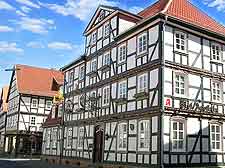
Rothenburg ob der Tauber has so many landmarks and sights, it's difficult to classify them but easy to see them all since the Altstadt, where most are located, is such a small area.
The town square, known as the Marktplatz (Market Square), is the main focus of activity in the town, and contains many of its landmarks and attractions, as well as a medieval townscape that charms everyone who visits.
Cafes and restaurants line up for attention, competing with the magnificent Rathaus and other heritage sites, such as the City Councillors' Tavern (Ratstrinkstube), which doubles as a heritage monument and the tourism office. In the town of Rothenburg ob der Tauber, getting away from its long and impressive history is impossible, even of you wanted to!
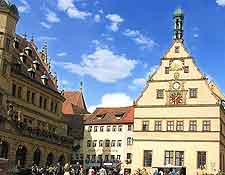
City Councillors' Tavern
Address: Marktplatz, Rothenburg ob der Tauber, Germany, DE
Tel: +49 09861 404 800
One of the town's major landmarks and also its tourist office, this impressive tavern was built for the privileged city councillors in 1446, with no-one else allowed inside, and is widely associated with the town's escape from total destruction in 1631, during the 30 Years' War. Catholic forces had threatened to destroy the City Councillors' Tavern, but it was saved by the mayor, who reputedly managed to down over three litres of wine in one go as the stated price for sparing the town. This amazing feat, known as the Masterdraught, is celebrated even today.
Open hours: business hours
Admission: free
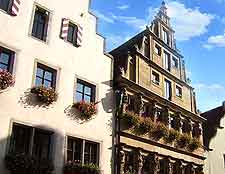
Master Builder's House
Address: Obere Schmeidgasse, off Marktplatz, Rothenburg ob der Tauber, Germany, DE
This beautiful house was home to stonemason Leonhard Weidmann and features a richly ornamented facade, a terraced gable and lintels depicting the seven virtues and seven vices, arranged in alternate carvings. Perhaps the best patrician house in the town, this landmark was built in 1596 for the Master Builder of the town and head of the local guild. Nowadays, the Master Builder's House serves as a cafe, with guests seated in the cosy inner courtyard.
Open hours: business hours
Admission: free
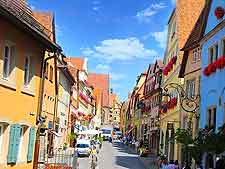
Plonlein
Address: Altstadt, Rothenburg ob der Tauber, Germany, DE
Perhaps the best-known sight in Rothenburg ob der Tauber is the Plonlein, featured on many postcards and pictures. The Plonlein is simply a scenic fork in the road resembling a small square, with one lane running downhill and the other upward towards the market place. The 14th-century Seibers Tower presides over the left-hand uphill fork and the Kobolzell Gate is visible to the right - a view which hasn't changed for literally hundreds of years.
Open hours: daily
Admission: free
Jewish Lane (Judengasse)
Address: Jewish Lane, Rothenburg ob der Tauber, Germany, DE
An important landmark for Judaism in Rothenburg ob der Tauber is Jewish Lane, one of the best-preserved Jewish medieval quarters in the whole of Germany. It contains buildings dating from the 13th century, when the town was a centre for Jewish scholarship. There is also a Jewish museum and a dance hall, destroyed during WWII and rebuilt in the 1950s.
Open hours: daily
Admission: free
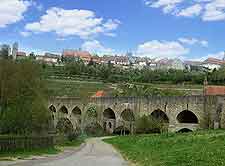
Medieval Double Bridge (Doppelbrucke)
Address: Outside the Kobolzeller Gate, Rothenburg ob der Tauber, Germany, DE
This unusual medieval double-decker bridge is set just outside of the town and is a worthwhile stop on the way to a day trip destination. The Doppelbrucke leads down from the town itself and connects the Tauber Valley, appearing rather like a historic aqueduct. Originally part of the town's defences, it is still well preserved and makes for a good photo opportunity.
Open hours: daily
Admission: free
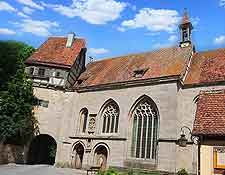
St. Wolfgang Fortified Church
Address: Klingen Gate, Rothenburg ob der Tauber, Germany, DE
This 15th-century fortified church was a landmark for the town's shepherds, being beautifully preserved in almost original condition. St. Wolfgang Fortified Church was built in the late Gothic style with dungeons, gun emplacements and very thick walls. The wood carvings on the altars are spectacular, and the gatehouse offers information about the traditional Shepherds' Dance.
Open hours: November to September, Monday, Wednesday to Sunday - 11:00 to 13:00, 14:00 to 17:00; October, daily - 11:00 to 16:00
Admission: free
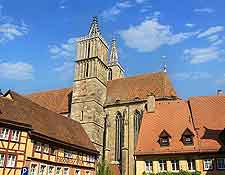
Church of St. Jacob (Jakobskirche)
Address: Klostergasse 15, Rothenburg ob der Tauber, Germany, DE
Tel: +49 09861 700 620
Literally reaching for the sky, this imposing church, with its twin towers, is the largest in the town and boasts two famous wooden altars fashioned by the 16th-century master-carver Tilman Riemenschneider, plus a high altar by another famous sculptor, Freidrich Herlin. The glorious Church of St. Jacob was built between the years of 1311 and 1484, and contains a relic of Christ, reputed to be a drop of his blood, which is housed within the carved Holy Blood altar (Heilige Blut). As a result, the Jakobskirche has become something of a major pilgrimage site.
Open hours: April to October, daily - 09:00 to 17:15; November, January to March, daily - 10:00 to 12:00; December, daily - 10:00 to 16:45
Admission: charge, discounts for children, students and groups
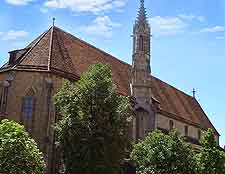
Franciscan Church (Franziskanerkirche)
Address: Herrengasse, Rothenburg ob der Tauber, Germany, DE
Tel: +49 09861 700 620
The Franciscan Church is the oldest in the town and was consecrated in 1309, recently celebrating its 700th anniversary. This church also boasts an altar carved by Tilman Riemenschneider, as well as a set of famous stained-glass windows by Johannes Schreiter and many plaques commemorating long-dead members of local wealthy patrician families and landed gentry. The nave is used for concerts and lectures, along with regular religious services.
Open hours: February to December, Monday to Saturday - 10:00 to 12:00, 14:00 to 16:00; Sunday - 14:00 to 16:00; closed January except for worship
Admission: free
 Rothenburg ob der Tauber has so many landmarks and sights, it's difficult to classify them but easy to see them all since the Altstadt, where most are located, is such a small area.
Rothenburg ob der Tauber has so many landmarks and sights, it's difficult to classify them but easy to see them all since the Altstadt, where most are located, is such a small area.





